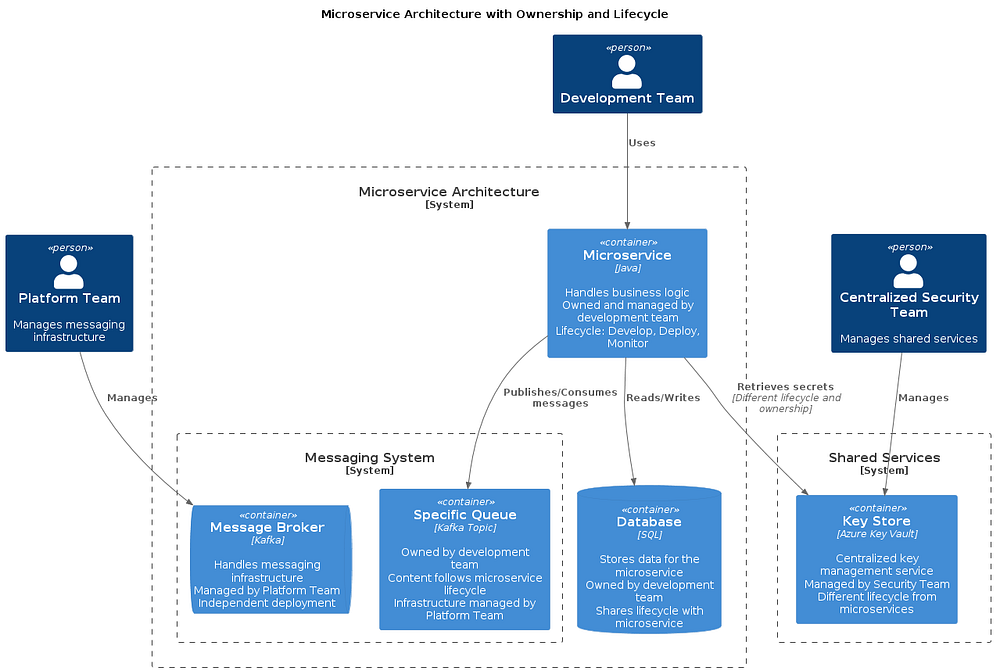From Silos to Synergy: Cloud Infrastructure Management in the Age of Platform Teams

Navigating Lifecycle and Ownership in Modern Infrastructure Architectures
Introduction
Software and the infrastructure it needs, have a complicated relationship. On one hand, a web app will need somewhere to run, but where it runs and how it gets there might vary.
Infrastructure and the software it serves can have different lifecycle and ownership. A microservice with a database is a good example of shared lifecycle and ownership. Different lifecycles are when the same microservice requires a message broker like Kafka. An example of different lifecycle and ownership? A microservice might need a key-value store while a centralized security team manages it.
The resulting architecture is typically more complicated than a hallo world IaC example.

Why does it matter?

Platform Teams are responsible for maintaining all the shared infrastructure. An excellent book, “Team Toplogies” claims.
“Platform teams produce and maintain the infrastructure and services that all of your teams use to communicate with each other and perform tasks. Examples of these kinds of services include your internal security tools, remote work applications, cloud storage solutions, and internal network design.”
I would like to argue that it depends. Depends on lifecycle and ownership. Remember the phrase “You build it, you run it” attributed to Werner Vogels, the CTO of Amazon? Death to silos and long live 2 pizza teams. It’s all great, if not always practical. Moreover, blindly following this rule might get us in trouble.
Silos are not bad
On the contrary, silos are amazing, when implemented right. Can you imagine being involved in the decisions of how to run your EKS cluster or Google Cloud Run?
Well, it’s your cluster and your container, so … run it. Thankfully, that’s not how it works. Cloud providers offer a self-service options and otherwise get out of the way. For all intents and purposes, they are silos where we throw our workloads over the fence and that’s it.
Cloud hyperscalers came up with guidelines that capture differences in ownership and lifecycle. They are called shared responsibility guidelines.
Rethinking Ownership in Tech
The tech industry’s approach to ownership and lifecycle management continues to evolve. While Werner Vogels’ “You build it, you run it” philosophy pushed for end-to-end ownership, reality often demands more nuance.
As Sam Newman points out in “Building Microservices”
“Microservices give us options in terms of how we implement our systems, but they don’t dictate the organizational structures we use.”
This applies to ownership models as well.
Different components typically have different lifecycles and ownership needs. A rapidly iterating microservice might be fully owned by a product team, while a shared database could be managed by a platform team. The key is finding the right balance for each organization’s unique needs.
“Good architecture allows major decisions to be deferred.” — Robert C. Martin
This flexibility in architecture should extend to our ownership models, allowing them to adapt as our systems and organizations grow and change.
Architecture Recommendations

In modern software development and infrastructure management, various techniques and tools have emerged to address the challenges of different lifecycle and ownership models. These include service discovery portals, self-service platforms, GitOps practices, Infrastructure as Code (IaC), and internal developer platforms (IDPs).
While these techniques are valuable, the underlying organizational architecture is crucial for their effective implementation. Here is an overview of organizational architecture models addressing each lifecycle/ownership permutation.
| Lifecycle | Ownership | Architecture/Organization Model |
|---|---|---|
| Application-bound | Developers | "You build it, you run it" model |
| Application-bound | External team | Embedded platform engineers |
| Shared | Developers | Complicated subsystem team |
| Shared | External team | Platform team approach |
Based on the analysis of lifecycle and ownership patterns, I recommend the following architectural approaches:
1. “You build it, you run it” model
Context: Application-bound infrastructure owned by developers
This model, popularized by Amazon, empowers development teams with full responsibility for their services, including infrastructure. It promotes:
- End-to-end ownership and accountability
- Rapid iteration and deployment
- Deep understanding of both application and infrastructure needs
Implementation often involves extensive use of cloud services, Infrastructure as Code, and robust CI/CD pipelines. Teams in this model benefit from self-service platforms and comprehensive monitoring tools.
2. Embedded platform engineers
Context: Application-bound infrastructure owned by an external team
This approach bridges the gap between specialized infrastructure knowledge and application-specific needs. Key aspects include:
- Close collaboration between platform experts and development teams
- Tailored infrastructure solutions that align with application requirements
- Knowledge transfer and upskilling of development teams
Successful implementation often involves creating service catalogs, implementing GitOps practices, and establishing clear communication channels between platform engineers and developers.
3. Complicated subsystem team
Context: Shared infrastructure owned by developers
This model, derived from Team Topologies, is suitable for managing complex, shared components that require deep expertise. Characteristics include:
- Focused team of specialists managing a critical, shared subsystem
- Clear interfaces and APIs for other teams to interact with the subsystem
- Continuous evolution and optimization of the shared component
Implementation might involve creating comprehensive documentation, establishing service level objectives (SLOs), and developing self-service interfaces for other teams to utilize the subsystem.
4. Platform team approach
Context: Shared infrastructure owned by an external team
This model centralizes the management of shared infrastructure, providing a foundation for other teams to build upon. Key features include:
- Dedicated team focusing on creating and maintaining shared infrastructure
- Emphasis on creating self-service capabilities for development teams
- Standardization of infrastructure practices across the organization
Successful platform teams frequently implement internal developer platforms (IDPs), use Infrastructure as Code for managing resources, and create service discovery portals to make their offerings easily accessible to development teams.
Closing Thoughts
As we’ve explored throughout this discussion, the relationship between software and infrastructure is complex and multifaceted. The architectural approaches we’ve outlined — from “You build it, you run it” to Platform teams — each align with specific lifecycle and ownership patterns, providing a foundation for effective infrastructure management.
It’s crucial to remember that there’s no one-size-fits-all solution. The choice of approach should be based on your organization’s specific needs, culture, and technical landscape. Factors such as team size, technical expertise, regulatory requirements, and business objectives all play a role in determining the most suitable architecture.
Moreover, it’s entirely possible — and often beneficial — for these models to coexist within the same organization. Different components or services may require different approaches. A critical, shared database might be best managed by a complicated subsystem team, while a customer-facing microservice could thrive under a “You build it, you run it” model.
The key is to remain flexible and open to evolution. As your organization grows and changes, so too should your architectural approach. Regular reassessment of your infrastructure management strategies can help ensure they continue to serve your needs effectively.
Thanks for taking the time to read this post. I hope you found it interesting and informative.
🔗 Connect with me on LinkedIn
🌐 Visit my Website
📺 Subscribe to my YouTube Channel